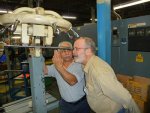Also, are you able to divulge how much TIR drift per inch yall's gundrill achieves on average? Is it a counter rotating drill?The earliest powered type cut rifling machines where around the civil war. That being said....hand pulled cut rifling was still being done here in the U.S. by guys like Pope, Zischang, Schoyen where being used till about 1900.
I’m going to look to see if I can find the news video from like the late 80’s. It was done I forget the reason why but they had a new crew in Afghanistan when Russia was pulling out. They are in what I call some remote tent city and if you want to call a tent a gunstore....you name it they had it. I even seen WW1 Luger Artillery pistol hanging from a rope etc....anyways they showed a group of guys hand making AK47’s and there was one guy sitting on the ground hand pulling a cut rifling head and he was hand cutting the rifling/grooves into a barrel!
Reason I ask.. Eg Preferred Barrel Blanks claims .00071"/in on average.... is this particularly straighter than many/most custom barrel makers?
I'd like to caveat that I know "straightness don't mean sh!t in regards to accuracy, within reason at least! As a matter of fact, quite a few successful long range benchrest shooters prefer a bit more curve as opposed to a bit less(as counter intuitive as that sounds.. its true, I've spoken with em)!!!!!! I also need to caveat that its highly likely you ain't gone see this "curve" with the naked eye holding the barrel in your hand.. you'd need to 9ut her ina lathe and spin it somewhat/fairly quick to see the "curve".. what most smihts do is index the tube so the curvature is pointed upward, so as to maximize LR trajectory/capability..
However, I DO theorize that its beneficial, even if only a lil bit, that the bore ID center-line be "concentric"(is that the rigjt word? Im 8 Yuenglings deep) to the barrel outer diameter...?? Ie if you ran 26" of floss in the exact center of the bore, from breech -> muzzle on 26" barrel, and then each millimeter from breech -> muzzle measured distance(or would it be radius??) from that point on the floss to a corresponding spot on the outer diameter of the barrel, and it was very consistent/more consistent than a group of other barrels, with all else being equal... I DO believe that manner/type of straightness/concentricity would be beneficial, whether talkin tapered or heavy straight BR/F-Class 1.250" and 1.450" even if only a small way. Eq; if the barrel walls' widths are consistent or close as possible to consistent, the barrel should expand more evenly and hence be a bit less affected by heat.




